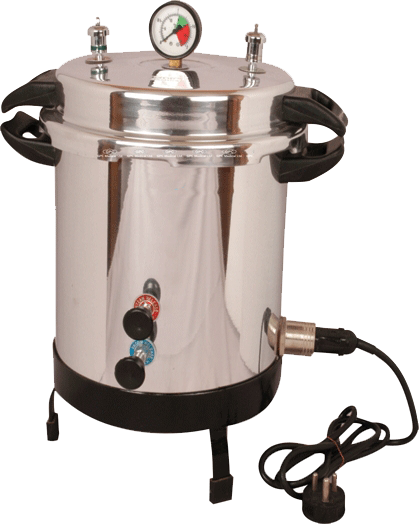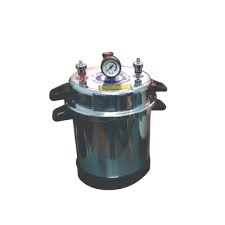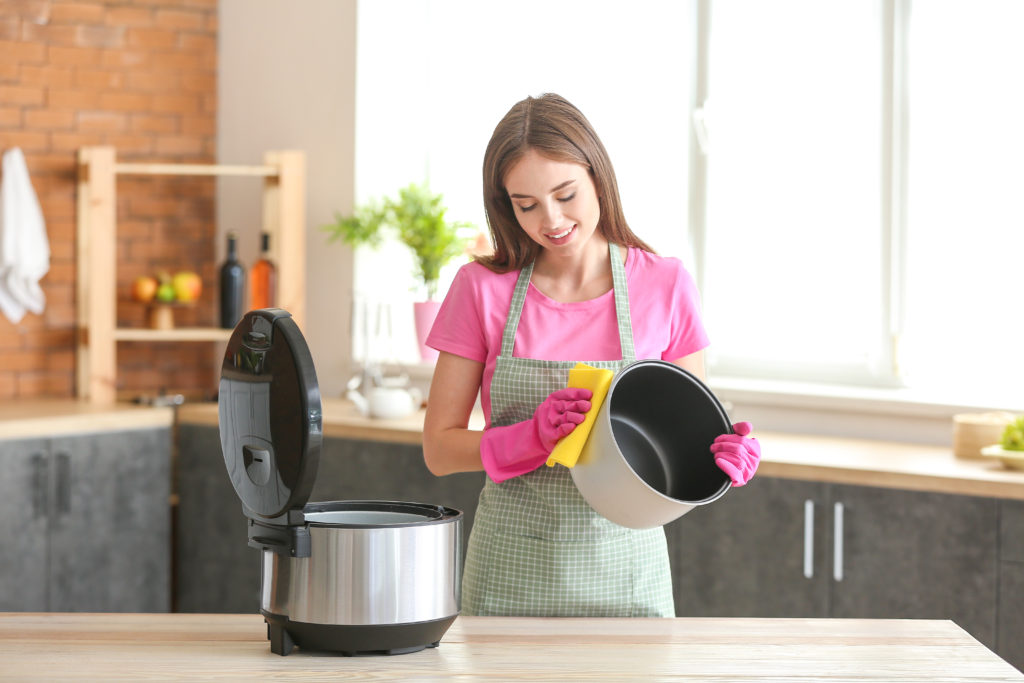Differences between an Autoclave and a Pressure cooker

I have a pressure cooker, but I prefer to cook food as well. Pressure is used to sterilize in both autoclaves and pressure cookers, but how does an autoclave compare to a pressure cooker?
I decided to investigate further and discovered:
An autoclave is a pressure device that uses dry steam to sterilize medical equipment. It is not utilized in the preparation of meals, and wet steam is used for cooking food in pressure cookers. However, you can use either one to sterilize or canned food. Autoclaves, on the other hand, use more pressure, resulting in a higher boiling point.
Steam sterilization is the most effective approach to sterilize both the container and the food.
This is best done in a machine that employs both heat and pressure to efficiently generate the maximum steam and sterilize.
When it comes to sterilizing, is a pressure cooker superior to an autoclave? These are critical questions to consider when canning at home.
So, let’s take a closer look at this subject.
What is the difference between an autoclave and a pressure cooker?
An autoclave is sterilization equipment that uses high pressure and high heat, and it is not used for cooking, unlike a pressure cooker. Surgical instruments, dental instruments, and laboratory equipment are commonly sterilized using these machines in the medical field.
However, we are not discussing autoclaves or medical equipment in this context.
In the food sector, autoclaves can be used to extend shelf life and sterilize containers that will be used to store food for more extended periods.
There are numerous sorts of autoclaves, each with its size, form, and function. They can sterilize a wide range of materials, including solids, liquids, hollow objects, and devices of all forms and sizes.
The functions of pressure cookers and autoclaves are incredibly similar. To make steam, they both rely on the strength of heat and pressure. Bacteria, spores, and germs resistant to boiling water and detergents can be killed this way.
The most significant distinction is that an autoclave is used purely for sterilization, whereas pressure cookers are utilized for, well, cooking. The increased pressure in an autoclave raises the boiling point of water, allowing it to hold more heat and kill microorganisms more effectively (source).
Is it possible to use a pressure cooker as an autoclave?

Because heat and pressure are necessary to function, a pressure cooker can be utilized as an autoclave. Autoclaves, on the other hand, employ dry steam, whereas pressure cookers use wet steam. As a result, sanitizing objects in a pressure cooker will make them wetter than sterilizing them in an autoclave.
However, it may be beneficial to examine all of the qualities of both to determine how they differ and compare.
We’ve already discussed what an autoclave performs. Steam and pressure are used only for sterilizing, and it is the most frequent method of sterilizing instruments and lab equipment in the medical and dental industries.
Pressure cookers, on the other hand, are built primarily for cooking. They employ a lot of pressure to keep the components under constant pressure and cook them with moist heat, which is accomplished by placing water or other liquids in the container with the ingredients.
Autoclaves sterilize using pressure and dry steam, while pressure cookers cook using pressure and wet steam. So, while they aren’t created for the same purpose, they work in the same way.
However, it would help if you did not use an autoclave as a pressure cooker because your food will lack the proper quantity of moisture.
A pressure cooker, on the other hand, can be used as an autoclave to some extent.
Although pressure cookers are not suggested for sterilizing medical devices, they can be used in the kitchen to sanitize household objects.
In an autoclave, what can’t be sterilized?
Items containing or being covered with solvents such as paint, paint remover, or other harsh chemicals should not be sterilized in autoclaves. Items that contain corrosive compounds or recognized carcinogens should also be avoided.
Autoclaves may sterilize several materials, as we briefly described before.
Solids, liquids, hollow substances, and instruments of all shapes and sizes are among them. Some items, however, cannot be sterilized in an autoclave.
Of course, you won’t need to know most of these when working in your kitchen. However, when it comes to glass and plastics, you must be aware of what can and cannot be sterilized in an autoclave.
When sterilizing with your pressure cooker, keep this list in mind, especially regarding the sort of glass you’ll be utilizing for canning.
Pyrex is constructed of borosilicate glass, which is highly durable. Mason jars for canning are composed of heat-tempered glass, which can resist the high temperatures and pressures of the process.
In a pressure cooker, how do you sterilize?

Add 1-2 inches of water to a pressure cooker to sanitize it. Place a metal rack in the bottom of the pressure cooker, add the goods, and close the lid. Set the pressure cooker to 15 psi and cook for at least 15 minutes.
Older Instant Pots may not be capable of reaching that PSI, but newer models or devices with a “high” setting will.
While some argue that sterilizing glass canning jars isn’t strictly necessary, it is a good idea to do so when preserving fruits and vegetables. This aids in the killing of microorganisms and promotes a longer shelf life. And, you guessed it, you can do it with your pressure cooker.
You could boil your jars, but as we’ve seen, steam sterilization with a pressure cooker or autoclave is far more effective.
Before using your pressure cooker or Instant Pot to sterilize in your kitchen, read the instruction booklet carefully. If your pressure cooker is in good working order, you can use it as an autoclave by following these general instructions.
Here’s more information on what I just mentioned.
- Fill the chamber with a couple of inches of water.
- Inside, place your containers on top of anything to keep them from immediately touching the floor. When glass canning jars are placed directly on the bottom, they can crack.
- Seal the pressure cooker and place it on the burner according to the manufacturer’s instructions. If you’re using an Instant Pot, make sure it’s turned on.
- Maintain a pressure of 15 psi in your pressure cooker for at least 15 minutes. If you are canning food that contains 15% or more salt, you may need to simmer it for an additional 5-10 minutes.
- Before removing the lid, remove the pressure cooker from the heat source and naturally depressurize. If you’re using an Instant Pot, switch it off and let the pressure naturally dissipate without opening the vent.
When placing items in your pressure cooker, always use caution, and let them cool completely before touching them with your bare hands.
In an autoclave, how much pressure is there?
Most autoclave machines sterilize with steam at around 15 pounds per square inch (psi) and around 250 degrees Fahrenheit.
When dealing with anything under duress, safety should always be your top priority.
On the other hand, a stovetop pressure cooker can produce pressures ranging from 12 to 21.7 psi. The working pressure of the Instant Pot, on the other hand, is between 10.15 and 11.6 psi. Due to the heat conduction delay, it may reach 15.23 psi at any time.
With so much pressure on these machines, some people may be concerned about the possibility of an explosion.
When sterilizing in your pressure cooker, however, you should still take the required measures.
You want to avoid harm as well as any unneeded glass and another material breakage. Do not place any glass containers directly on the pressure cooker’s bottom, and this will expose the container to too much direct heat, which may cause it to break.
It would help if you also made sure that there wasn’t too much pressure inside the container. Don’t overfill your jars when canning, and keep the lids free to prevent pressure building and steam penetration.
Before you start sterilizing with your pressure cooker, double-check that everything is in working condition. Most pressure cookers and Instant Pot devices have several safety measures.
Safety aspects of modern pressure cookers include:

- Close detection of the lid
- Under pressure, the lid locks.
- Controlling the pressure automatically
- Protection for the pressure regulator
- Protection from excessive pressure
- Automatic temperature regulation
- Handles for safety
- Warnings about extreme heat
- Mechanisms for releasing steam
When it comes to operating your pressure cooker, there is nothing to be concerned about.
Have I explained everything there is to know about the differences between an autoclave and a pressure cooker?
We’ve covered a lot of ground here.
First, we discussed what an autoclave is and how it sterilizes tools made of various materials using steam. Then we looked at how pressure cookers work similarly and sterilize canning jars and other kitchen items. Finally, we talked about how to use these machines safely at home.
Hopefully, this clarifies the differences between an autoclave and a pressure cooker.
Have I explained everything there is to know about the differences between an autoclave and a pressure cooker?
- We’ve covered a lot of ground here.
- First, we discussed what an autoclave is and how it sterilizes tools made of various materials using steam. Then we looked at how pressure cookers work similarly and sterilize canning jars and other kitchen items. Finally, we talked about how to use these machines safely at home.
Hopefully, this clarifies the differences between an autoclave and a pressure cooker.











